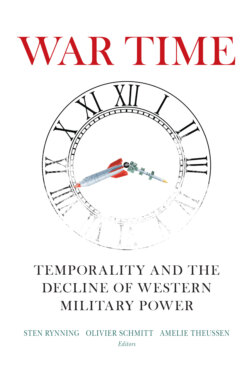Читать книгу War Time - Группа авторов - Страница 27
На сайте Литреса книга снята с продажи.
NOTES
Оглавление1 1. Joe Dunford, “The Character of War & Strategic Landscape Have Changed,” DoDLive, April 30, 2018, www.dodlive.mil/2018/04/30/dunford-the-character-of-war-strategic-landscape-have-changed/. Dunford is citing James N. Mattis, “Remarks by Secretary Mattis on the National Defense Strategy,” transcript, US Department of Defense, January 19, 2018.
2 2. Olivier Schmitt, “Wartime Paradigms and the Future of Western Military Power,” International Affairs, vol. 96, no. 2 (2020), pp. 401–18. See also chapter 9 by Pascal Vennesson in this volume.
3 3. See Philip E. Tetlock, Political Judgement: How Good Is It? (Princeton University Press, 2006).
4 4. Antulio J. Echevarria, “Toward an American Way of War,” Strategic Studies Institute Monograph (March 2004), www.ssi.armywarcollege.edu/pdffiles/00365.pdf.
5 5. Michael Howard, “Jomini and the Classical Tradition in Military Thought,” in Studies in War and Peace (London: Temple Smith, 1970), p. 31.
6 6. See Antoine-Henri Jomini, The Art of War, first published 1838 (Westport, CT: Greenwood Press, 1971).
7 7. John M. Cairns, “International Politics and the Military Mind: The Case of the French Republic, 1911–1914,” The Journal of Modern History, vol. 25, no. 3 (September 1953), p. 282.
8 8. For a fuller articulation of this argument, see A. J. P. Taylor, War by Timetable: How the First World War Began (London: Macdonald & Co., 1969).
9 9. Stephen Van Evera, “The Cult of the Offensive and the Origins of the First World War,” International Security, vol. 9, no. 1 (Summer 1984), pp. 58–107.
10 10. Robert Pape, Bombing to Win: Air-Power and Coercion in War (Cornell University Press, 1996).
11 11. See David S. Fadok, John Boyd and John Warden: Air Power’s Quest for Strategic Paralysis (Maxwell AFB, Montgomery, AL: Air University Press, 1995).
12 12. Harlan Ullman and James Wade, Shock and Awe: Achieving Rapid Dominance (Washington, DC: National Defense University Institute for National Security Studies, 1996). p. 11.
13 13. Edward N. Luttwak, Strategy: The Logic of War and Peace (Harvard University Press, 1987), pp. 4–5.
14 14. Ibid., p. 28.
15 15. Mattis, “Remarks by Secretary Mattis on the National Defense Strategy.”
16 16. Robert Wilson Lynd, Searchlights and Nightingales (London: J.M. Dent, 1939), p. 67.
17 17. John R. Allen and Amir Husain, “On Hyperwar,” Proceedings, vol. 143, no. 7 (July 2017), pp. 30–37.
18 18. Ibid., p 36.
19 19. Ibid., p. 37.
20 20. T. X. Hammes, “The Melian’s Revenge: How Small, Frontline, European States Can Employ Emerging Technology to Defend Against Russia,” Atlantic Council Issue Brief, June 2019.
21 21. Ibid., p. 11.
22 22. Ibid., p. 12. See also T. X. Hammes. Deglobalization and International Security (Amherst, NY: Cambria Press, 2019).
23 23. Ibid., p. 73.
24 24. Carl von Clausewitz, On War, translated and edited by Michael Howard and Peter Paret (Princeton University Press, 1989).
25 25. See Elbridge A. Colby, “Testimony Before the Senate Armed Services Committee Hearing on Implementation of The National Defense Strategy,” www.armed-services.senate.gov/imo/media/doc/Colby_01-29-19.pdf.
26 26. Andreas Umland, “Crimea Could Become an Expensive Liability for Putin,” Atlantic Council, June 10, 2020, https://www.atlanticcouncil.org/blogs/ukrainealert/crimea-could-become-an-expensive-liability-for-putin/.
27 27. Clausewitz. On War, p. 605.
28 28. Ibid., p. 605.
29 29. Ibid., p. 607.
30 30. Luttwak, Strategy, p. 31.
31 31. Williamson Murray, Military Adaptation in War: With Fear of Change (Cambridge University Press, 2011), p. 9.
32 32. Joseph Maiolo, Cry Havoc: How the Arms Race Drove the World to War, 1931–1941 (New York: Basic Books, 2010).
